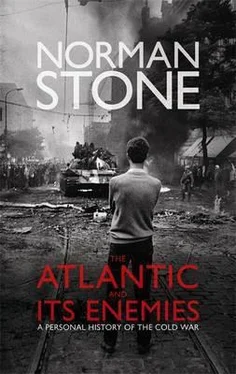The most characteristic book of the eighties was written not long after the decade ended, Francis Fukuyama’s End of History (1992). The title seemed funny when the book appeared, and seemed even funnier afterwards, but it was not senseless. The claim (a quote from Hegel) was that democracy and capitalism (‘free markets’) had spread from period to period after the Second World War, that dictatorships, Communism, wars, etc. would be things of the past, and that the world would move more and more in the direction of, say, Denmark. The essential was a decent level of prosperity, after which politics could move from Third to First World. Walt Rostow, back in the 1960s, had said much the same about industrialization. A point came when a country could ‘take off ’ into self-sustaining growth: England at the time of the Industrial Revolution, Germany somewhat later. ‘Big picture’ books of this sort were easy enough to pick apart, but they did connect with a substantial literature of Europe around 1900, when it was perfectly obvious that Western civilization had produced something unique, which needed explanation, and which countries such as Japan or Turkey might copy. Fukuyama’s contribution was only hesitantly stated. Its centre was that a modernizing dictatorship, or at any rate a period of rule without real elections, might be necessary for the ‘take-off ’, whether political or economic, to be arrived at. The question would have been accepted by any Communist in the 1930s: the peasants, Marx’s quadrupeds, would only accept progessive change if they were forced to. Modernization from the Left was a standard line, and was accepted very widely indeed. Since the Second World War a school of development economics had emerged, with the Swede Gunnar Myrdal in the lead, and its adepts were all around, whether in Africa or Latin America, arguing in effect that the peasantry and the small bourgeoisie should pay for heavy industrialization, courtesy of the State.
But in 1976, by the time Mao Tse-tung had died, that scheme of things looked much less promising. China, after all, had gone through convulsions, disasters, tens of millions of people dead of starvation, and the USSR was also hardly an advertisement. Development economics had grown out of the Marshall Plan, and something had gone badly wrong: the more aid, the more backwardness, however you were to explain this. In remote relationship, much the same happened with the Keynesian assumptions as regards public spending and unemployment: much of England was Third World, in German eyes, though there were only low-level civil wars. And now there was a Pinochet, creating considerably more prosperity than anything Communist; quite soon thereafter, 2 million Soviet citizens were taking refuge in, of all places, Turkey. What was going right, and what, wrong?
In Chile, in the first four years, to 1977, the aim was consolidation of the regime, a depoliticization of life, and a suppression of political parties and labour unions: farmers to farm, workers to work, students to study. There would have to be a currency reform, to put an end to the inflation: the State, printing its own money, was paying for its hangers-on at the expense, in taxes and rising prices, of people just trying to do a useful job outside the system. These matters had been analysed by political economists since the time of Adam Smith, two centuries beforehand, and economists in that tradition had swept the board in the nineteenth century. The State should be confined to its proper functions, in the way of defence, the rule of law and a money the value of which could be trusted. This brought about extraordinary progress in the later nineteenth century. But then had come 1914 and the big State had seemed to be the answer: world wars and the great crash of 1929, when finance and trade had collapsed, had seen to that. But this generated problems of its own, and these had been obvious enough to a particular school of political economists in central Europe even before 1914. The Austrian empire had been a very peculiar place, never really captured by western European liberal economics. Even in 1914 it employed a quarter of the population, and there was a legendary tragi-comic bureaucracy, the tax laws taking up three huge volumes, printed in two columns in small print on thin paper. Lawyers swarmed, and the general atmosphere was summed up by the great journalist of the era, Karl Kraus, when he said that Vienna was an asylum where you were allowed to scream. By 1934 there was a semi-dictatorship, trying to assert financial (and other: divorce was banned) orthodoxies. Its leader, Engelbert Dollfuss, faced a revolt from the Left. The army brought up artillery against a huge fortress-like public housing development called Karl-Marx Hof in Heiligenstadt, otherwise an upper-middle-class district; shells flew. The photographs of that, in the snows of February 1934, became one of the great Comintern tableaux, and two very prominent British Communists, one of them a major spy, became involved with left-wing Austrian women of that vintage. But that atmosphere also produced a school of political economists who looked upon the whole business and wondered what had gone wrong with the comfortable certainties of 1914. Like Keynes, they had a weakness for answering the problem in terms of mathematics. Hayek and Schumpeter had got out, via London, to Chicago and Harvard. Ludwig von Mises got out to Switzerland, and the oddest remark made, upon the outbreak of the Second World War, was made by him at Bern station to Wilhelm Röpke, later the architect of the West German economic miracle, whom he encountered by chance, as he transferred from Istanbul to Switzerland: if the Anglo-French free-trade treaty had been ratified by Louis Napoleon, this war would not have happened. In its surreal central European way, this stated a truth: countries that ignored the economic rules would distort everything and end up with a disaster. This ended up with the bombardment of the Karl-Marx Hof by the artillery of Prince Schönburg-Hartenstein. It also ended up with the Pinochet coup. The University of Chicago took in the Austrian school, Hayek in particular. In the USA universities competed with each other, and there was freedom in ideas. Chicago had always striven to acquire a character different from the Ivy League places, which listened to grand siren voices from England. Milton Friedman and others of his tendency worked there. In Chicago, at any rate, there were young men and women who had listened to what Hayek and his disciples had to say, and there were young Chileans who had attended the same classes. There had, since 1956, been a formal link between Chicago and the Catholic University in Santiago. In Allende’s Chile, Friedman had much to chew upon, and Pinochet’s Chile became the test case for an experiment that was to prove to be of worldwide importance.
Allende himself had stood on what appeared to be a formidable rock of thinking. Why was Chile poor, much poorer than Argentina? The Argentinian Raúl Prebisch argued powerfully that in Latin America big estates counted as a bottleneck, and in Chile they predominated — 80 per cent of the land held by 7 per cent of the farms, each with a thousand hectares on average, whereas 37 per cent of the farms held 0.2 per cent of the land. These figures seemed to reflect ‘social injustice’, and development economists argued that, because there were so many very poor peasants, there was not proper demand for industrial goods. The rich just imported them, and otherwise did nothing for economic growth except employ servants who, in the poorest countries such as Haiti, themselves employed servants. In the USA, there was a great deal of head-shaking as to what had gone wrong, the role of the USA included. Kennedy, as part of a campaign to limit the appeal of Castro, promoted an ‘Alliance for Progress’, with grants of money for ‘structural reforms’ in Latin America, and the Chilean Christian Democrats promoted land reform, though they did so prudently: carried out too quickly it could damage production. There was a problem for Chile, in that half of the population lived in the central valleys, not in the immense areas to north and south: vast estates on endless tracts of valueless land hardly made any difference, one way or the other, and some of them worked efficiently enough. They would have worked more efficiently, as experience was to show, had Chilean produce been freely bought and sold in the richer markets. But these protected their own agriculture: no-one knew Chilean wines until much later. Over the pace of land reform, the Christian Democrats split three ways, and their alliance with the Right disintegrated, which was the background to the election of Allende. That had ended in tears.
Читать дальше












![Edward Ellis - Adrift on the Pacific - A Boys [sic] Story of the Sea and its Perils](/books/753342/edward-ellis-adrift-on-the-pacific-a-boys-sic-s-thumb.webp)